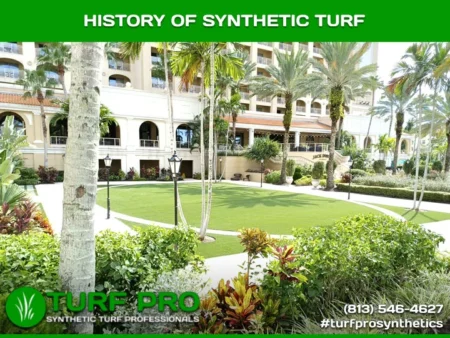 Today, synthetic turf is commonly used on athletic fields, but it’s changed dramatically and in many ways (e.g., surface design and maintenance) since it first originated over 50 years ago. Therefore what we have today is significantly different from what it was like when it was originally introduced.
Today, synthetic turf is commonly used on athletic fields, but it’s changed dramatically and in many ways (e.g., surface design and maintenance) since it first originated over 50 years ago. Therefore what we have today is significantly different from what it was like when it was originally introduced.
The History of Synthetic Turf
There have been many changes to artificial turf as it “grew up” and matured into what we have today. These different changes are what’s commonly referred to as “generations.”
First Generation
In 1966 the Houston Texas Astrodome was the first major sporting venue to install artificial turf. At that time, it was a dense nylon carpet composed of short fiber that was installed over the top of a soil base that was compacted. The following year a cushion made from a closed-cell, elastomeric foam was installed between the carpet backing and the soil. Eventually, this product that was created by ChemGrass began being referred to as AstroTurf.
During the 1970s and 1980s, AstroTurf was installed in several existing stadiums, as well as many that were newly constructed. People were intrigued by this because the surface was able to withstand a lot of traffic and still provided players with a consistent surface to play on.
Another nice thing about this new playing surface was that cities could now construct stadiums that could be used for various purposes since they had movable seating. Here they were able to host various concerts and sporting events without a lot of time between each event since it was more difficult to damage the playing surface.
Second Generation
By the late 1980s, people started criticizing this synthetic turf saying that it may be contributing to the injuries athlete were receiving while playing. Therefore Frederick T. Haas introduced a new type of artificial turf that he invented in 1976. This had a pad that absorbed shock beneath a carpet with much longer fibers than those that were initially used. Up to a few millimeters from the carpet, fibers were filled with silica sand so that these fibers were able to stand upright. The United States never widely adopted these playing surfaces. Nevertheless, they did pave the way for the modern, third-generation systems which are now widely used.
Third Generation
In 1997 FieldTurf created the first of the third-generation systems, which were installed at a high school in Pennsylvania. This generation of synthetic turf is similar to that of the second generation. They have an infilled system which means that there’s granular material between the vertical pile fibers. In this case, the infill material that’s used consists of crumb rubber, which is sometimes combined with silica sand. This is different from what was used in most second-generation systems as they tended to use pure sand. There are several companies, besides FieldTurf, who have now created similar products.
Now that you know how much synthetic turf has evolved over the past five decades, isn’t it time to have some installed around your home? Turf Pro Synthetics in Tampa, FL, is here to help you with that. Give us a call today, and we’ll be more than happy to go over all your options.
